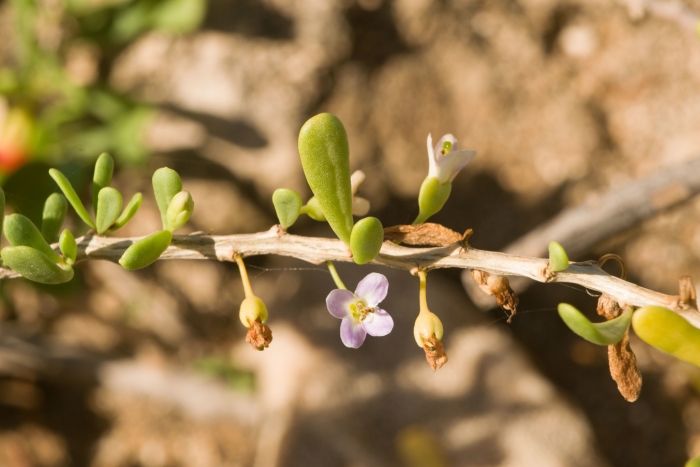ʻōhelo Kai
(Lycium sandwicense)
ʻōhelo Kai (Lycium sandwicense)
/
/

Kevin Faccenda
CC BY 4.0
Image By:
Kevin Faccenda
Recorded By:
Copyright:
CC BY 4.0
Copyright Notice:
Photo by: Kevin Faccenda | License Type: CC BY 4.0 | License URL: http://creativecommons.org/licenses/by/4.0/ | Rights Holder: Kevin Faccenda | Publisher: iNaturalist | Date Created: 2022-01-16T11:33:56-08:00 |

























Estimated Native Range
Summary
Lycium sandwicense, commonly known as ʻōhelo kai, is a perennial shrub native to the coastal strand vegetation and dry shrublands of the Hawaiian Islands. It typically grows to a height of 1-3 feet (0.3-0.9 meters) with a similar spread. The plant has a sprawling form and produces small, tubular purple flowers throughout the year, with peak flowering occurring in the spring. The flowers are followed by bright red, spherical berries that are both ornamental and a food source for native bird species. The berries are also edible to humans and have cultural significance in Hawaiian traditions.
ʻŌhelo kai is valued for its ability to stabilize coastal dunes due to its spreading habit and deep root system, making it an excellent choice for erosion control. It is also used in native plant restoration projects and as an ornamental in seaside gardens. In cultivation, it requires full sun exposure and thrives in sandy, well-drained soils. While it is drought-tolerant once established, regular watering can promote more vigorous growth and berry production. This shrub is relatively low-maintenance but can be susceptible to root rot if overwatered or planted in poorly drained soils.CC BY-SA 4.0
ʻŌhelo kai is valued for its ability to stabilize coastal dunes due to its spreading habit and deep root system, making it an excellent choice for erosion control. It is also used in native plant restoration projects and as an ornamental in seaside gardens. In cultivation, it requires full sun exposure and thrives in sandy, well-drained soils. While it is drought-tolerant once established, regular watering can promote more vigorous growth and berry production. This shrub is relatively low-maintenance but can be susceptible to root rot if overwatered or planted in poorly drained soils.CC BY-SA 4.0
Plant Description
- Plant Type: Shrub
- Height: 6-10 feet
- Width: 4-6 feet
- Growth Rate: Moderate
- Flower Color: Blue, Pink, White
- Flowering Season: Summer, Fall, Winter
- Leaf Retention: Deciduous
Growth Requirements
- Sun: Full Sun, Part Shade
- Water: Medium
- Drainage: Medium, Fast
Common Uses
Drought Tolerant, Edible*Disclaimer: Easyscape's listed plant edibility is for informational use. Always verify the safety and proper identification of any plant before consumption., Low Maintenance
Natural Habitat
Coastal strand vegetation and dry shrublands of the Hawaiian Islands
Other Names
Common Names: Hawaiian Wolfberry, Hawaiian Boxthorn, Pua Nako Nako [Rapa Nui], ‘Ōhelo kai
Scientific Names: , Lycium sandwicense, Lycium carolinianum var. sandwicense,
GBIF Accepted Name: